''Come along in and have some tea!'' says Bilbo Baggins, in J.R.R Tolkien's book 'The Hobbit!' Bilbo does have the right idea as a cup of tea is the perfect accompaniment to our Old-Fashioned English Seed Cake!
Our seed cake recipe may be egg-free, dairy-free, and prepared with vegan-friendly ingredients, but it is prepared with everyday pantry ingredients, and has all the flavours and textures of a classic seed cake - soft, spongy, fluffy, moist, sweet, buttery - with similarities to a Madeira or Pound Cake. We like to use Stork baking spread and soya milk for our seed cake but of course you can replace those with your usual ingredients.
Caraway seeds are the traditional seed for a seed cake but you can switch these out and bake a tasty Traditional Poppy Seed Cake.
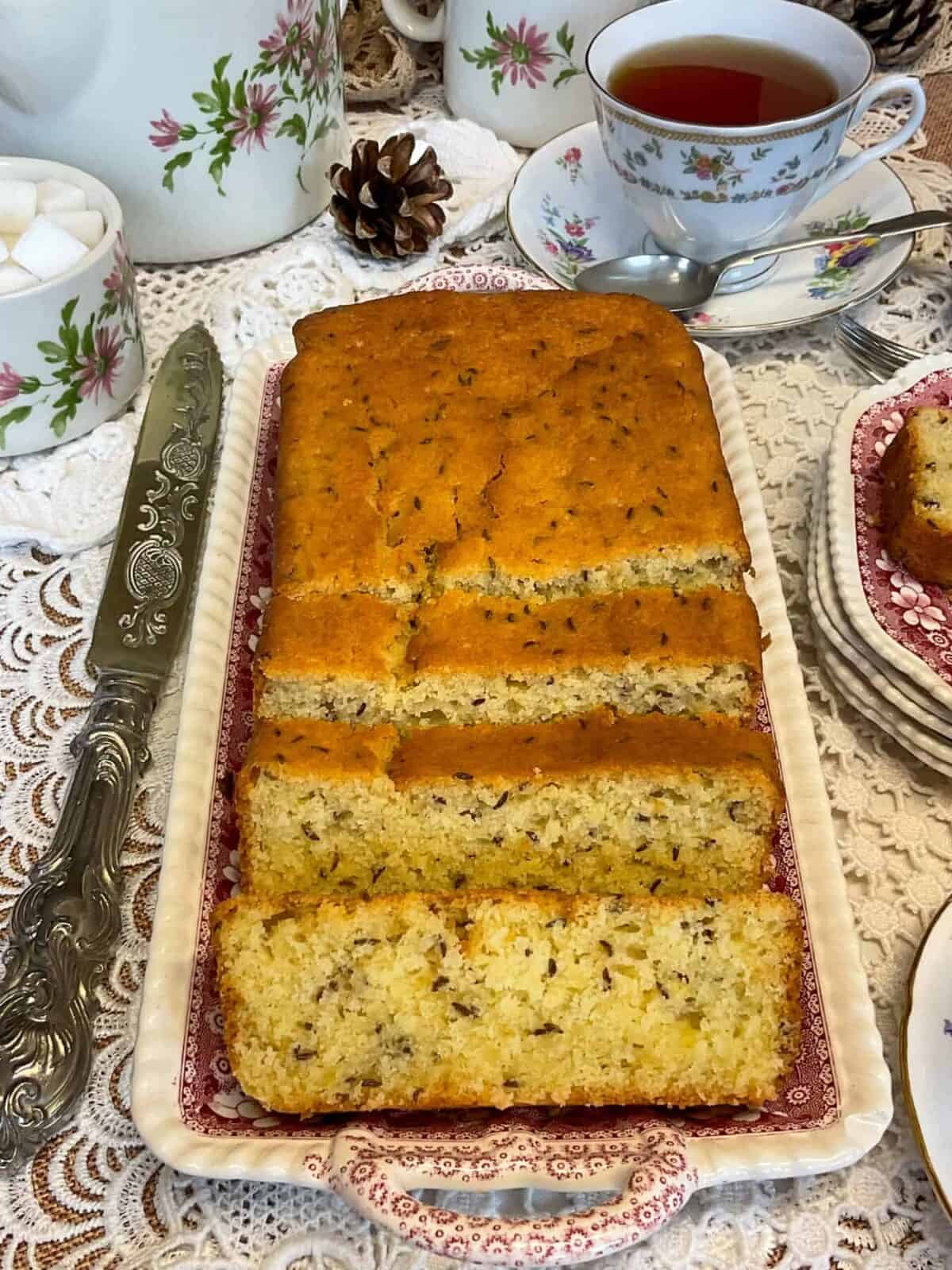
If you're a Hobbit fan then you may already know that Bilbo Baggins loves Seed Cake and at the request of Balin the Dwarf he brings out his seed cakes. Friday the 22nd September is National Hobbit Day and the perfect excuse to try out some hobbit favourite foods especially a tasty seed cake. Tolkien claims that hobbits spend most of their time growing food and eating food which sounds like a pretty good way to spend your time!
Jump to:
- Origin of old-fashioned seed cake
- Caraway seeds in ancient Roman times
- Old seed cake recipes
- Eliza Acton's Seed Cake [1845]
- Mrs Beeton's seed cake [1861]
- 20th century seed cake
- Bilbo Baggins Hobbit seed cakes
- Ingredients
- How to prepare
- Recipe notes
- Storage
- FAQ'S
- More traditional bakes - made egg-free & dairy-free
- 📖 Recipe
Origin of old-fashioned seed cake
The traditional English seed cake is a classic bake, that is flavoured with caraway seeds, and dates back to at least the 16th century. Caraway seeds have a long history in European cooking, and have been used since the ancient Egyptian and Roman times for both cooking and health benefits. The seeds have a slightly sweet, subtle anise-liquorice-citrusy-peppery like flavour which gives the cake its unique taste. Although, our tub of caraway seeds claim the seeds have minty tones as well.
Caraway seeds in ancient Roman times
Caraway seeds, are the seeds of the Carum carvi plant, which originate in Asia, Europe, and Africa where the plant has been used for thousands of years, with archaeological evidence of its use dating back to the Neolithic era. The ancient Egyptians are known to have used caraway seeds especially for medicinal purposes, as remains of caraway seeds have been found in archaeological digs of ancient tombs.
The ancient Romans likely got their caraway seeds through trading routes that extended into the Mediterranean, as well as India, China, the Middle East, and the Arabian Peninsula.
Caraway seeds were a popular spice in ancient Rome and were used in a variety of ways particularly in cooking and medicine. For example, caraway seeds were added to cooking, baking, wine, and they were believed to aid digestion and help freshen breath. Caraway was also used in perfumes and mouthwashes, and used as a medicine for ailments such as bronchitis, coughs, etc.
Caraway seeds were also fed to chickens, sprinkled around property as protection against theft, and used in love portions as they were believed to be a symbol of love and fidelity.
During the Roman Empire and occupation of Britain [43 AD to 410 AD] the Romans introduced many different foods including caraway seeds.
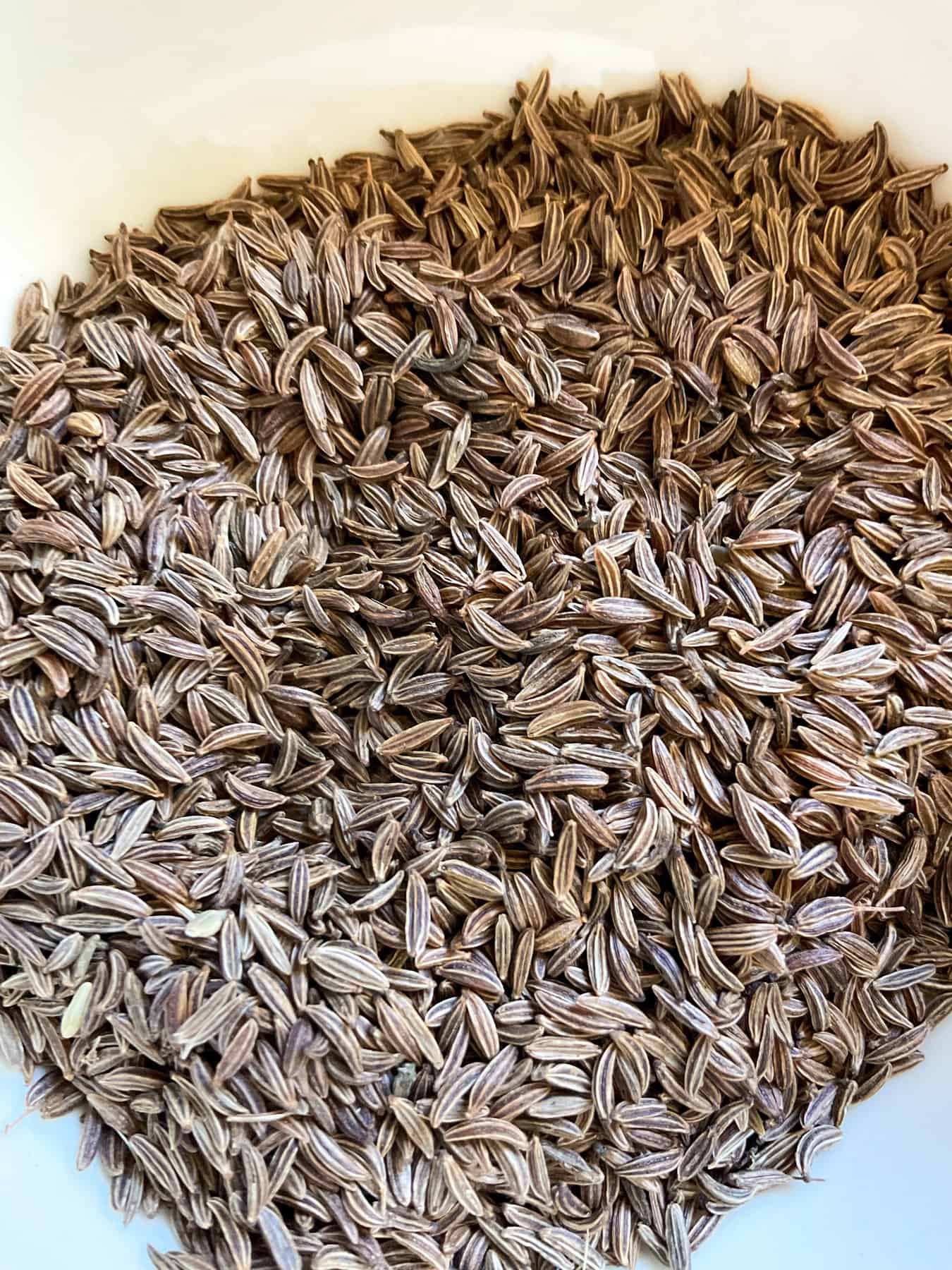
Caraway seeds do provide cakes with a distinctive flavour and if you like the flavour of these little long stripy seeds, then you'll likely want to bake another caraway seed cake. The seeds are just too tasty when baked into a sweet buttery sponge cake. Slices of cheese are a nice savoury accompaniment.
Old seed cake recipes
The tradition of adding caraway seeds to cakes in Britain dates back many centuries and according to Elizabeth Ayrton seed cakes were:
''enormously popular from the sixteenth century to the end of the nineteenth century, or even up to the First World War. Thomas Jusser, writing in 1580, mentions 'The Seede Cake' as traditional for the feast which marked the end of the spring wheat sowing''
Elizabeth Ayrton [The Cookery of England, pg 520, 1974]
Seed cakes were often made for special occasions like feasts and celebrations, with the seeds believed to have health benefits and were regarded as a symbol of love and fidelity, so they were an especially popular addition to wedding cakes.
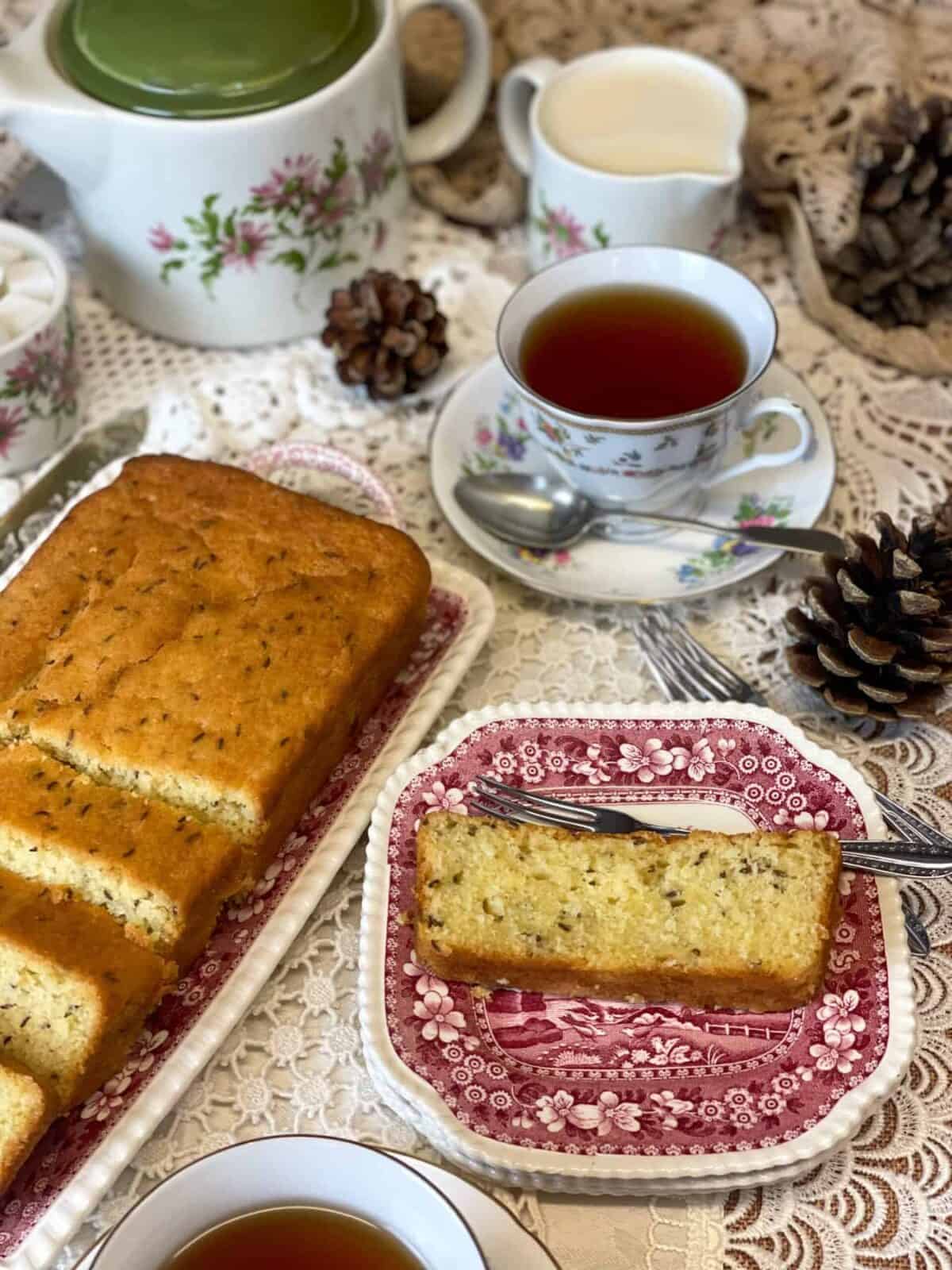
Surprisingly, caraway seeds are technically the dried fruit of the caraway plant and the actual caraway seed is contained within the tiny crescent shaped stripy pods that we use for baking. Another interesting fact is that caraway is part of the same family as parsley, celery, and carrot.
Eliza Acton's Seed Cake [1845]
Eliza Acton's 1845 cookery book ''Modern Cookery for Private Families'' contains a recipe for a 'Plain Pound or Currant Cake' [pg546] which is also called a 'Rich Brawn Brack' or 'Borrow Brack'.
Acton writes that adding dried currants and candied peel to the plain cake converts it into a plum cake whereas adding caraway seeds creates a speckled Irish bread otherwise known as a Brawn Brack. Acton advises that currants can also be added but are generally omitted.
Acton's Brawn Brack recipe does seem similar to the traditional Irish Barmbrack which in modern times is a yeasted currant bread.
Acton also has a recipe for a ' A Very Cheap Luncheon Biscuit, or Nursery Cake' which involves enriching ready-made bread dough with sugar, butter, spices, and caraway seeds [pg555].
Mrs Beeton's seed cake [1861]
Another mention of cakes with caraway seeds is found in Mrs. Beeton's "Book of Household Management" (1861). Mrs Beeton has several cake recipes with caraway seeds including 'A Very Good Seed-Cake', and 'A Nice Plain Cake', and 'A Nice Plain Cake For Children'.
'The Good Plain Cake For Children' is similar to Acton's nursery bread-cake, as it is more of a sweet bread than a cake, as it's a bread dough which is enriched with sugar, butter, milk, and either nutmeg or caraway seeds. Whereas the 'Nice Plain Cake' is prepared with flour, baking powder, dripping, sugar, eggs, milk, currants, and caraway seeds.
Mrs Beeton's 'Very Good Seed Cake' is much richer as it contains more eggs, lots of butter, sugar, brandy, mace and nutmeg, and of course caraway seeds. Although, Mrs Beeton also advises that the cake would be ''equally nice'' if the caraway seeds were replaced with currants.
Old Victorian recipes do seem to demonstrate that cakes and breads enriched with caraway seeds are commonly regarded as good sustenance for small children, which does shows how tastes change over the years as caraway seeds are not exactly thought of the flavour of choice for kids nowadays!
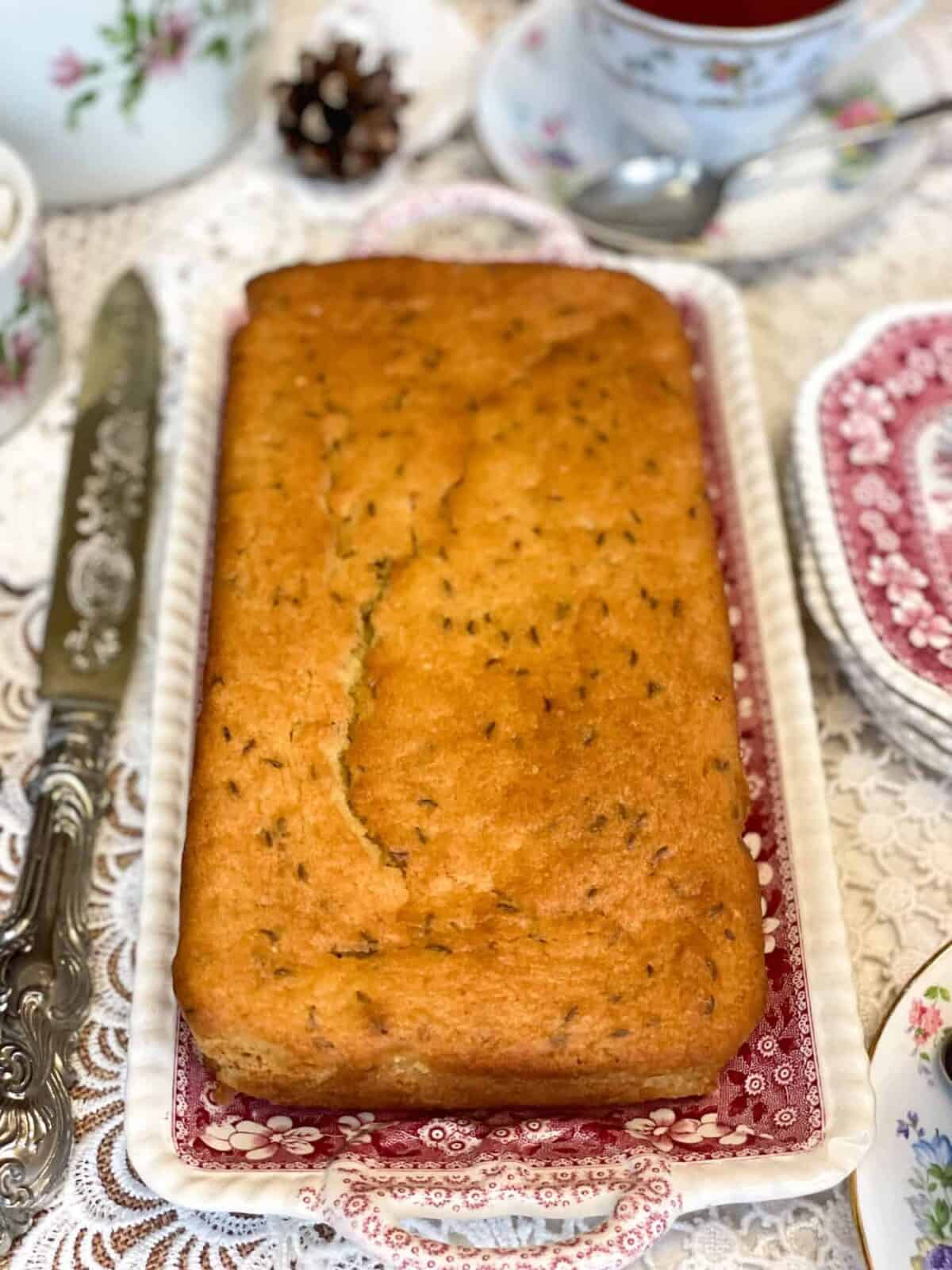
20th century seed cake
In Florence White's book ''Good Things In England'' [1932] there are two recipes for seed cake one is for a 'Rich Seed Cake' and the other a 'Plain Seed Cake'. The 'Rich Seed Cake' recipe, is from a Mrs Martin, Frome, and dated 1852, and contains a pound of butter, six eggs, castor sugar, flour, and caraway seeds which the recipe states can be replaced with caraway essence if the texture of the seeds are not liked.
Whereas the 'Plain Seed Cake', is from a recipe contributor titled MS and dated 1904, and contains less butter and eggs, castor sugar, cream of tartar, bicarbonate of soda, salt, milk, and caraway seeds or caraway essence.
Both seed cake recipes are under the chapter 'Country and Schoolroom Teas' and the chapter introduction builds a picture of cosy country house teas, farmhouse teas, schoolroom teas, tea parties, cricket teas, all filled with ''homely favourite cakes'' and ''everything was home-made, the bread and the cakes and the scones'' [pg281].
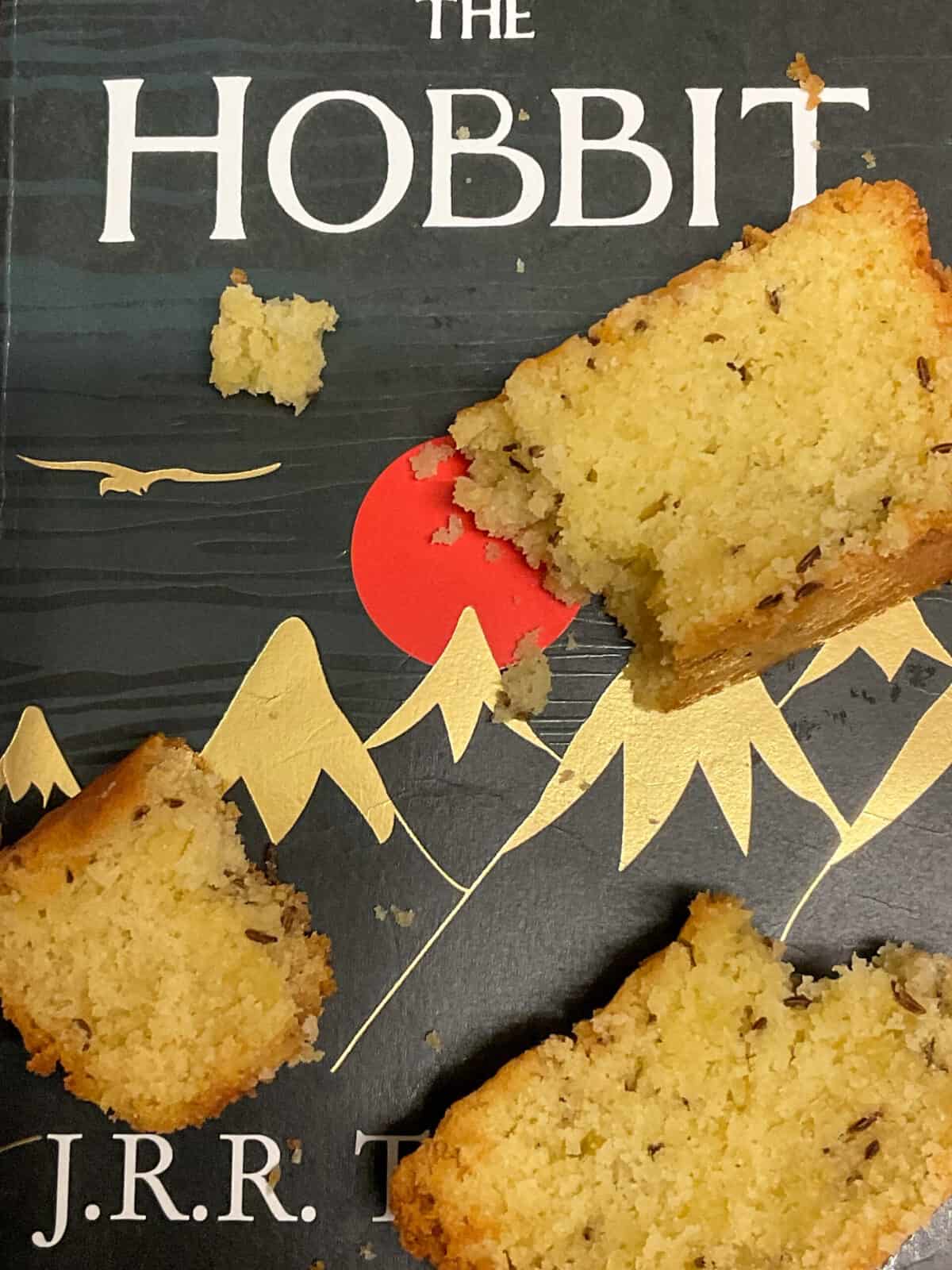
This photo of our tasty seed cake is three days old and the cake is still delicious and moist. I have been enjoying slices for breakfast with cups of green tea.
Bilbo Baggins Hobbit seed cakes
The idea of seed cakes is less popular in more modern times but as it was most famously mentioned in J.R.R. Tolkien's book "The Hobbit" [1937] and the film ''The Hobbit: An Unexpected Journey'' [2012], it has enjoyed somewhat of a revival of interest.
The first chapter of The Hobbit is titled ''An Unexpected Party'' and Bilbo is receiving unexpected guests in the form of 13 dwarfs...
''Come along in, and have some tea!'' he managed to say after taking a deep breath. ''A little beer would suit me better, if it's all the same to you, my good sir,'' said Balin with the white beard. ''But I don't mind some cake - seed cake, if you have any''. ''Lots!'' Bilbo found himself answering, to his own surprise; and he found himself scuttling off, too, to the cellar to fill a pint beer-mug, and then to a pantry to fetch two beautiful round seed-cakes which he had baked that afternoon for his after-supper morsel.
J.R.R Tolkien, The Hobbit, 2007 edition, pg9
J.R.R. Tolkien began writing "The Hobbit" in 1930 and the inspiration for the Shire, the hobbits idyllic village, is generally believed to have been his childhood experiences in the English countryside. Tolkien grew up in rural Birmingham and he spent a lot of time exploring the countryside, woods, and fields, and undoubtedly Tolkien experienced lots of traditional British home-cooking and classic tea time bakes, including seed cakes which fit in perfectly well with this era.
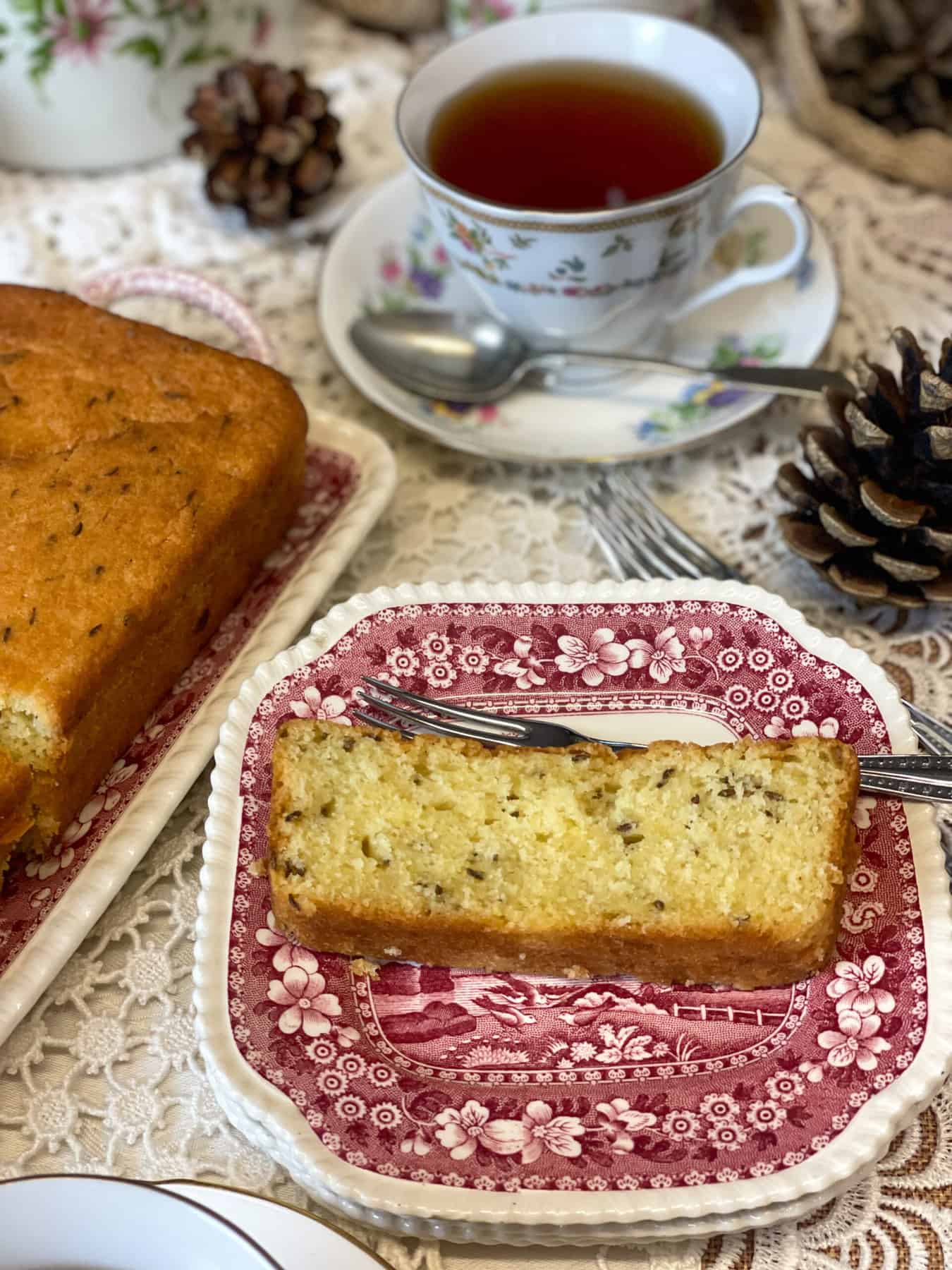
We have added a few pinecones, that were foraged one autumn on the Scottish island where our family lives, to our tea table as Hobbits like to decorate their cosy underground homes with large pinecones. We are all hobbit fans in our home.
Caraway seed cake has a rich history that spans the changing of the seasons. It has been enjoyed as an old harvest-time treat, served with tea to weary fieldworkers after long days of gathering crops. Similarly, it has been enjoyed in the spring, a welcome home-bake after sowing the new season's seeds.
Yet, its appeal goes beyond the agricultural calendar as seed cake has been included at feasts, celebrations, weddings, and even funeral teas. It has even captured the imagination of authors, as evidenced by its inclusion in works of fiction like 'The Hobbit'.
So why not bake a tasty seed cake, pop the kettle on, and enjoy a delicious taste of history? A dairy-free and egg-free, vegan-friendly seed cake is simply the next chapter in this cake's historical story.
Ingredients
The 8 ingredients you will need for this seed cake are:
- self-raising flour
- baking powder
- milk [we use soya milk but any milk will do]
- margarine or butter, suitable for baking [we used Stork baking margarine]
- lemon juice & zest
- granulated sugar
- caraway seeds
- salt [we used sea salt]
How to prepare
Seed cake is an easy bake and satisfies any cravings for tasty home-baking to enjoy along with afternoon tea, high tea, Devonshire tea, snack or supper-time.
We are a plant-based family so we use soya milk to prepare our buttermilk but if you have different dietary requirements you can use your usual milk. We also use Stork baking spread as it's labelled as vegan and works beautifully within cakes and bakes, but you can use your usual margarine or butter that you use for bakes.
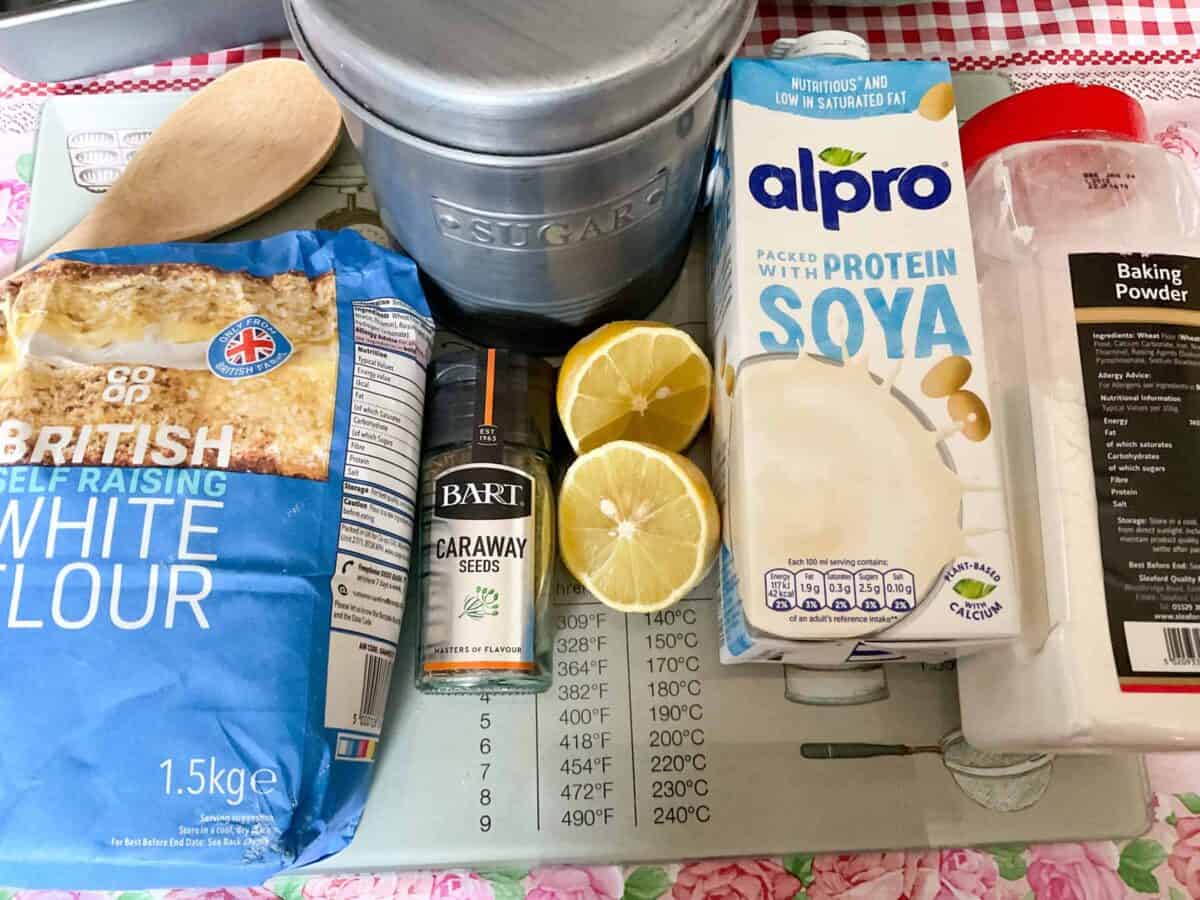

1. First, gather all your ingredients together. We used Stork baking block as we always achieve good baking results and cakes are always nice and buttery, but your usual baking margarine, butter, or block will be fine.
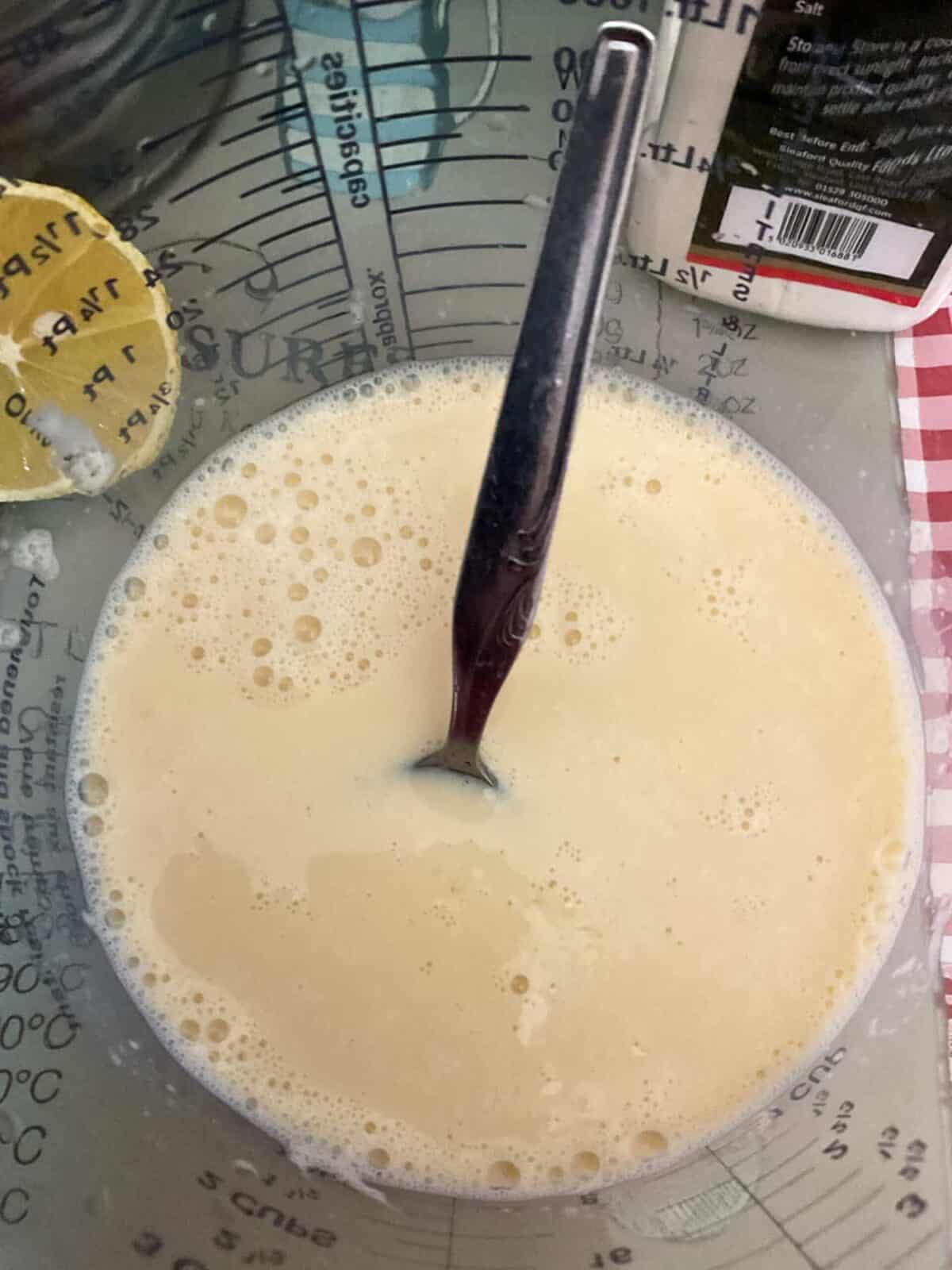
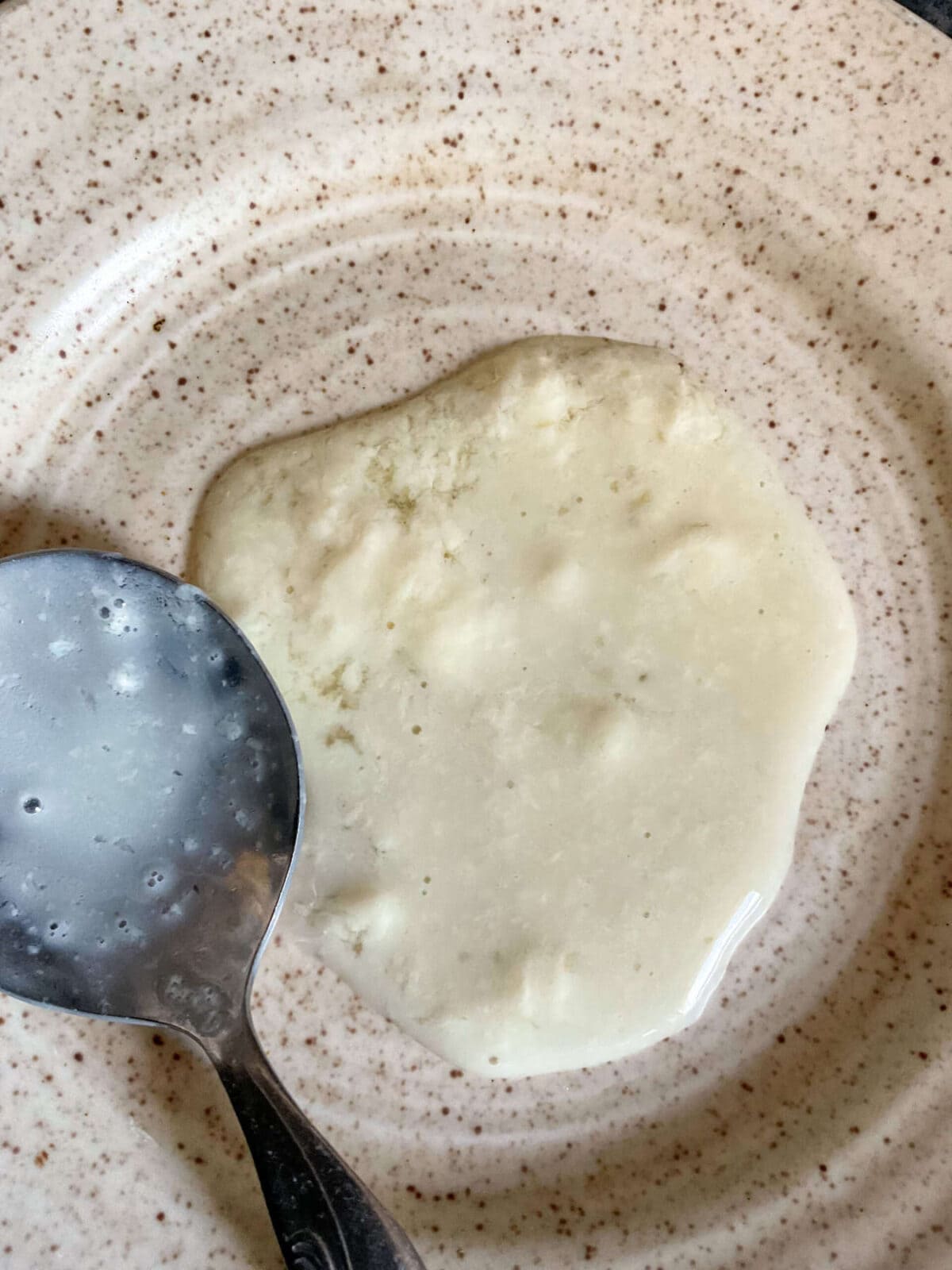
2. Prepare the buttermilk: [This stage can be prepped in advance.]
Pour the soya milk or your usual milk into a jug and mix through the lemon juice. Leave to curdle for at least 30 minutes or longer.
The second photo is just to show the consistency of our buttermilk once it had curdled. Some milks may not curdle as well but they are still fine to use.
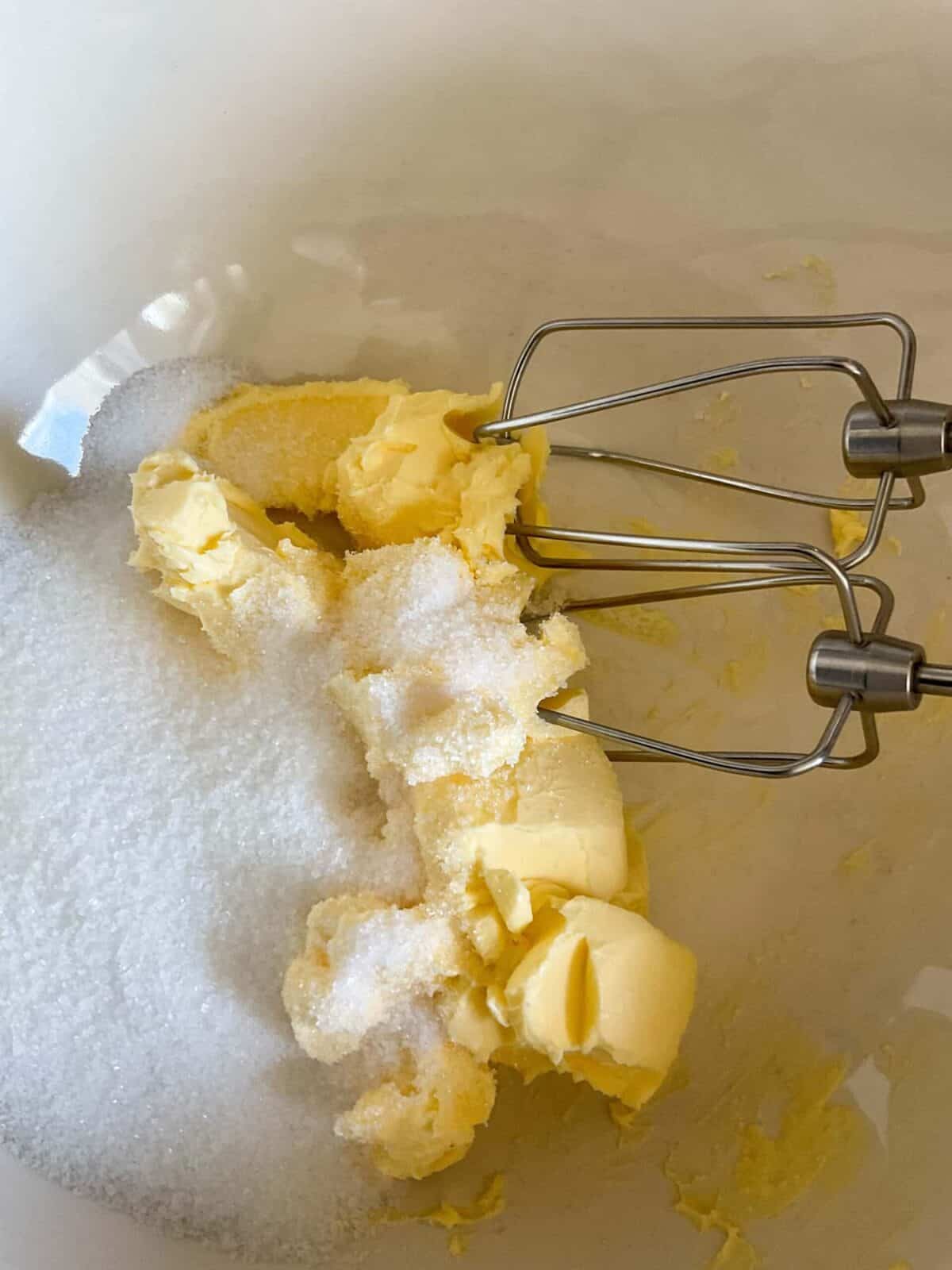
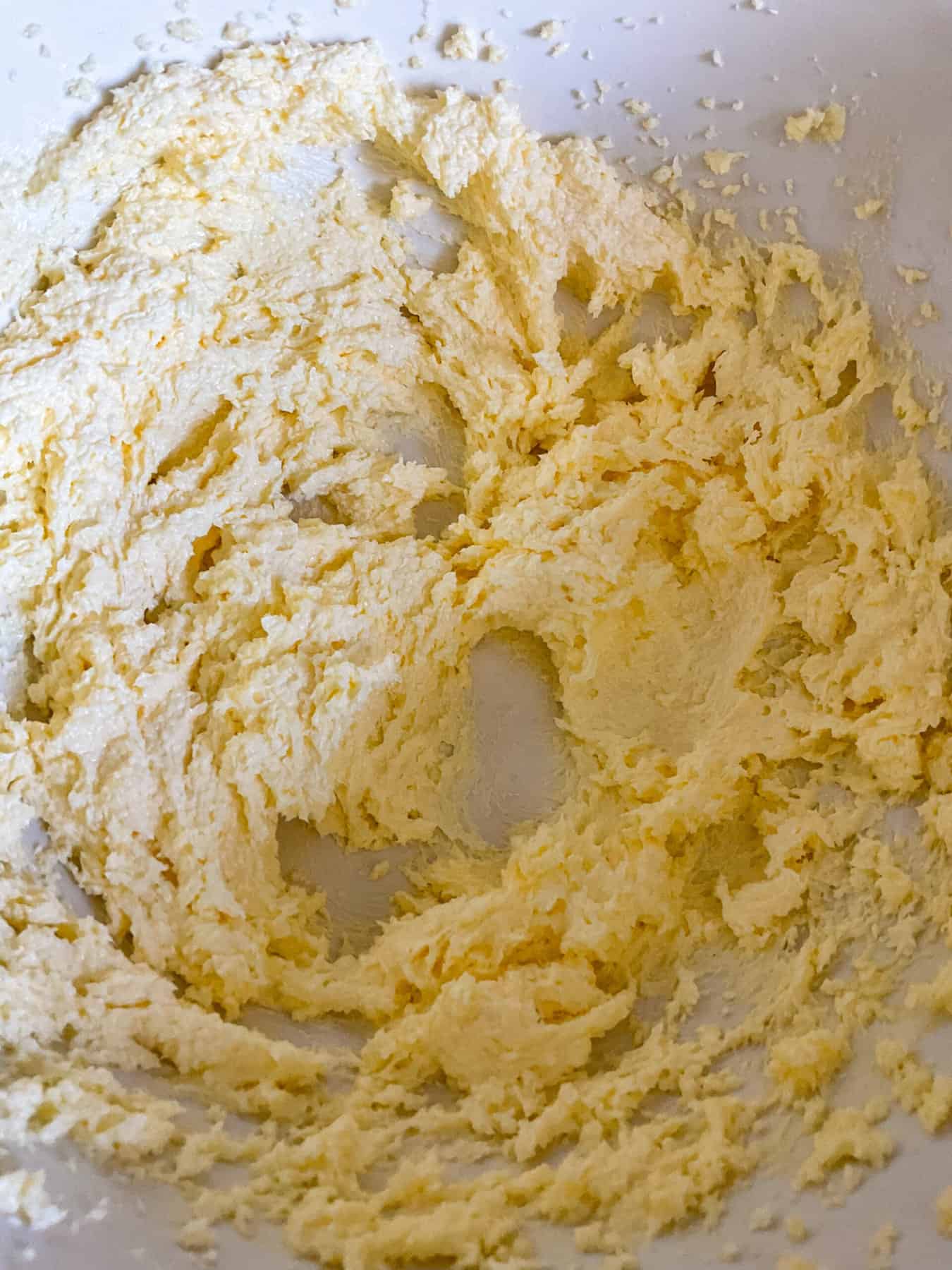
3. Add the margarine to a mixing bowl along with the granulated sugar.
4. Whisk with an electric hand whisk or similar, or by hand with a mixing spoon, until its fully incorporated.
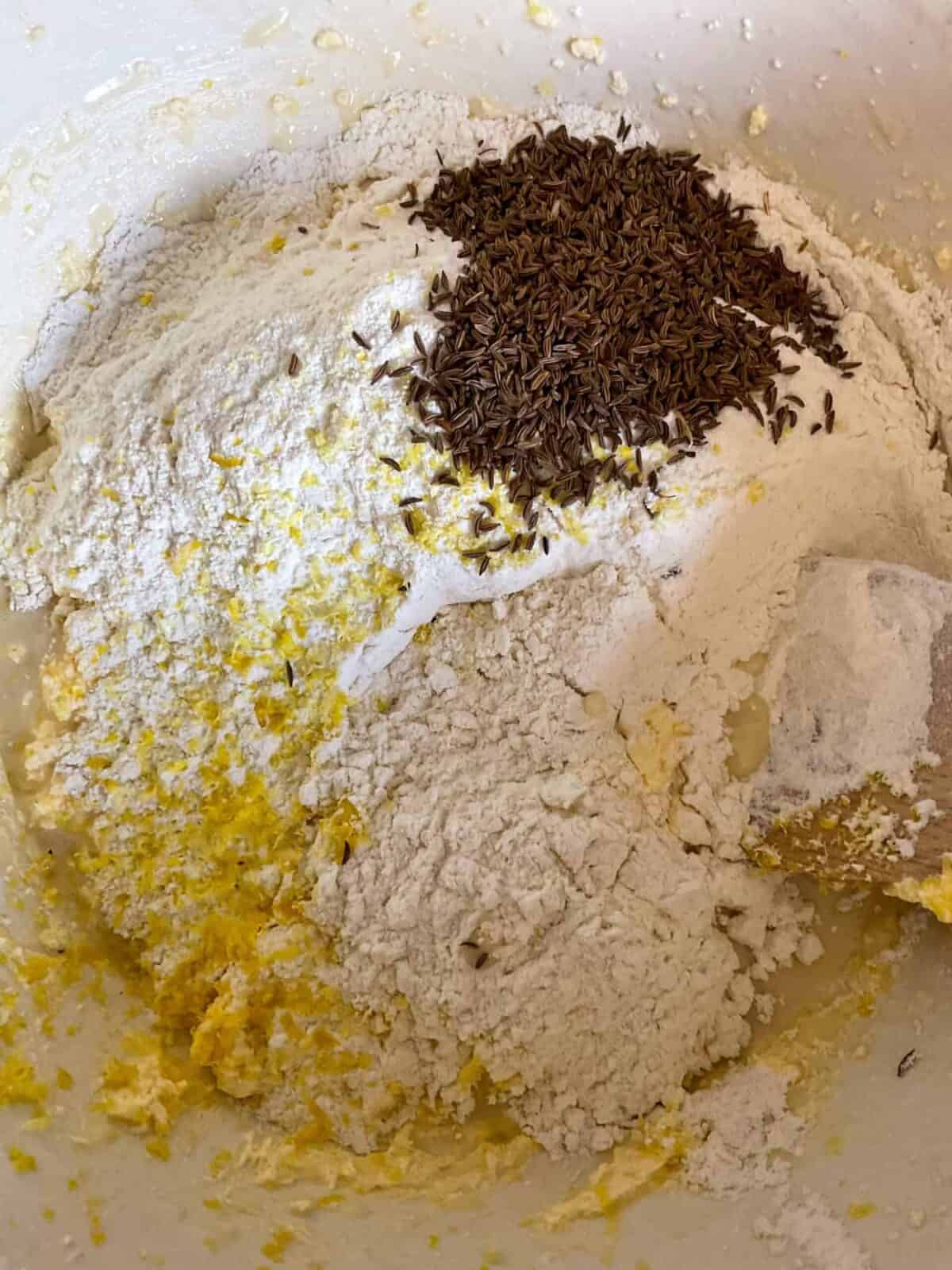
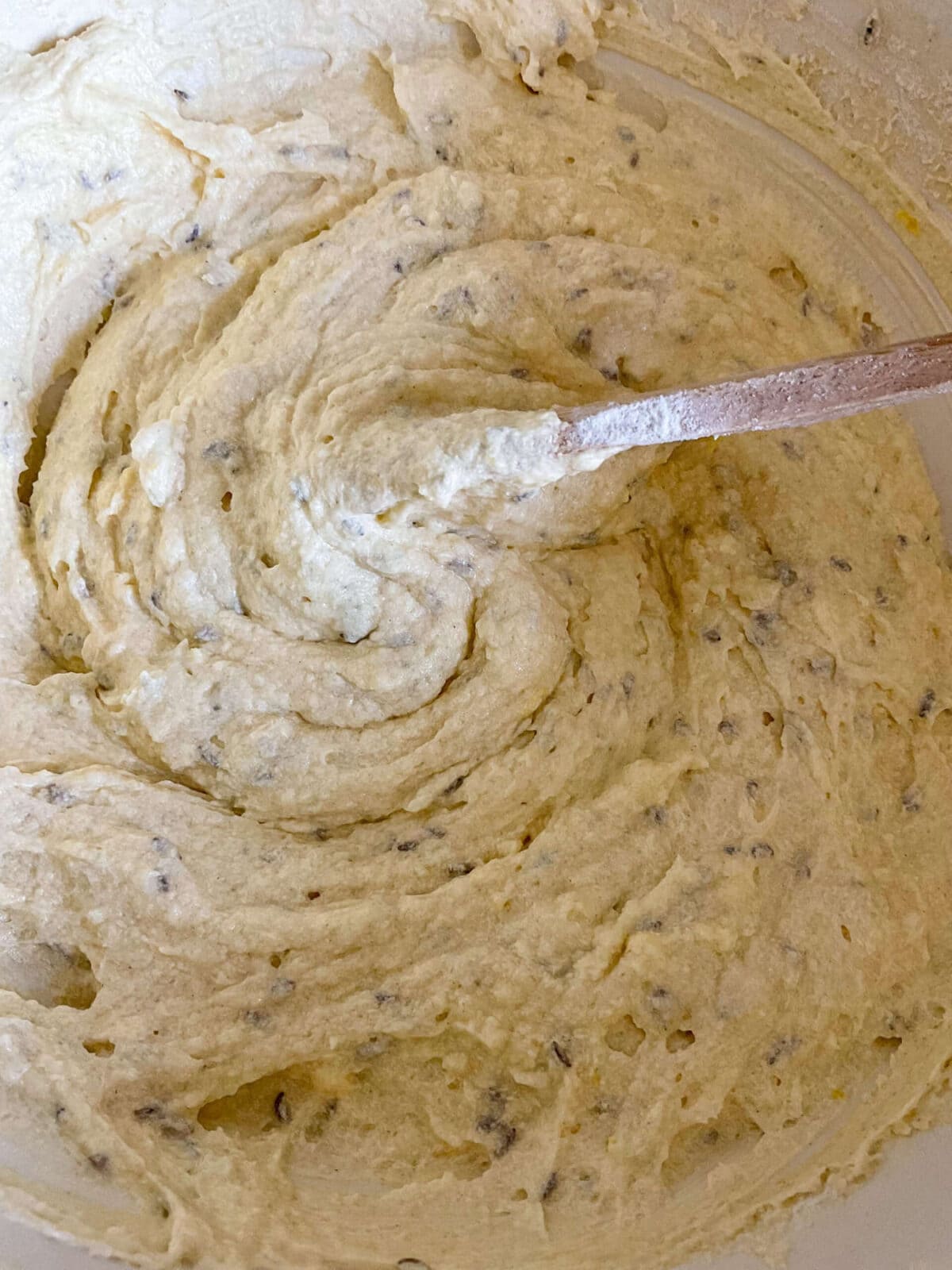
5. Pour in the buttermilk and whisk. It may look curdled but it will come together once the dry ingredients are added.
6. Next, sift in the self-raising flour and baking powder, and add the salt, lemon zest, and caraway seeds [or poppy seeds].
7. Mix everything together by hand with a mixing spoon.
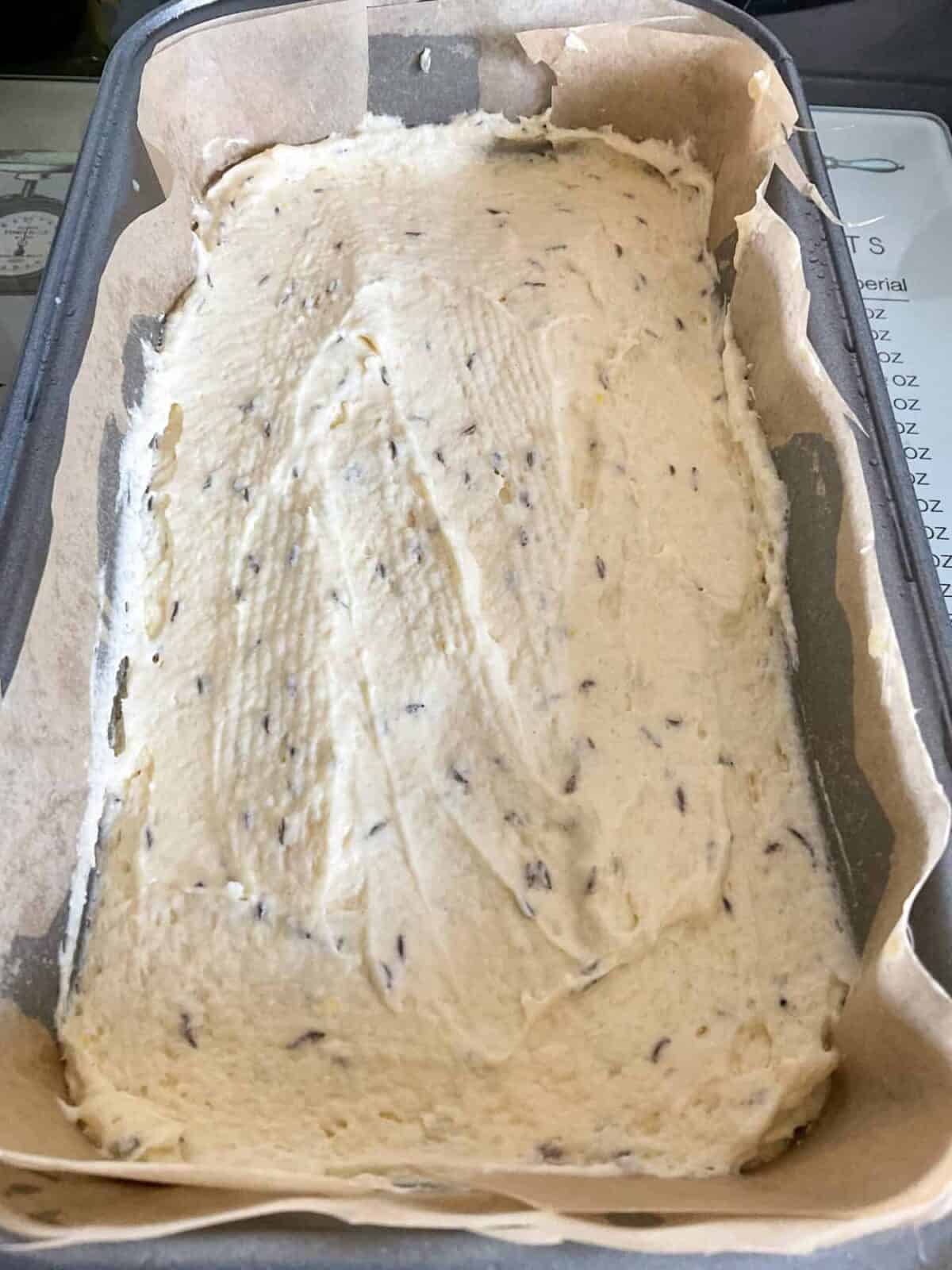
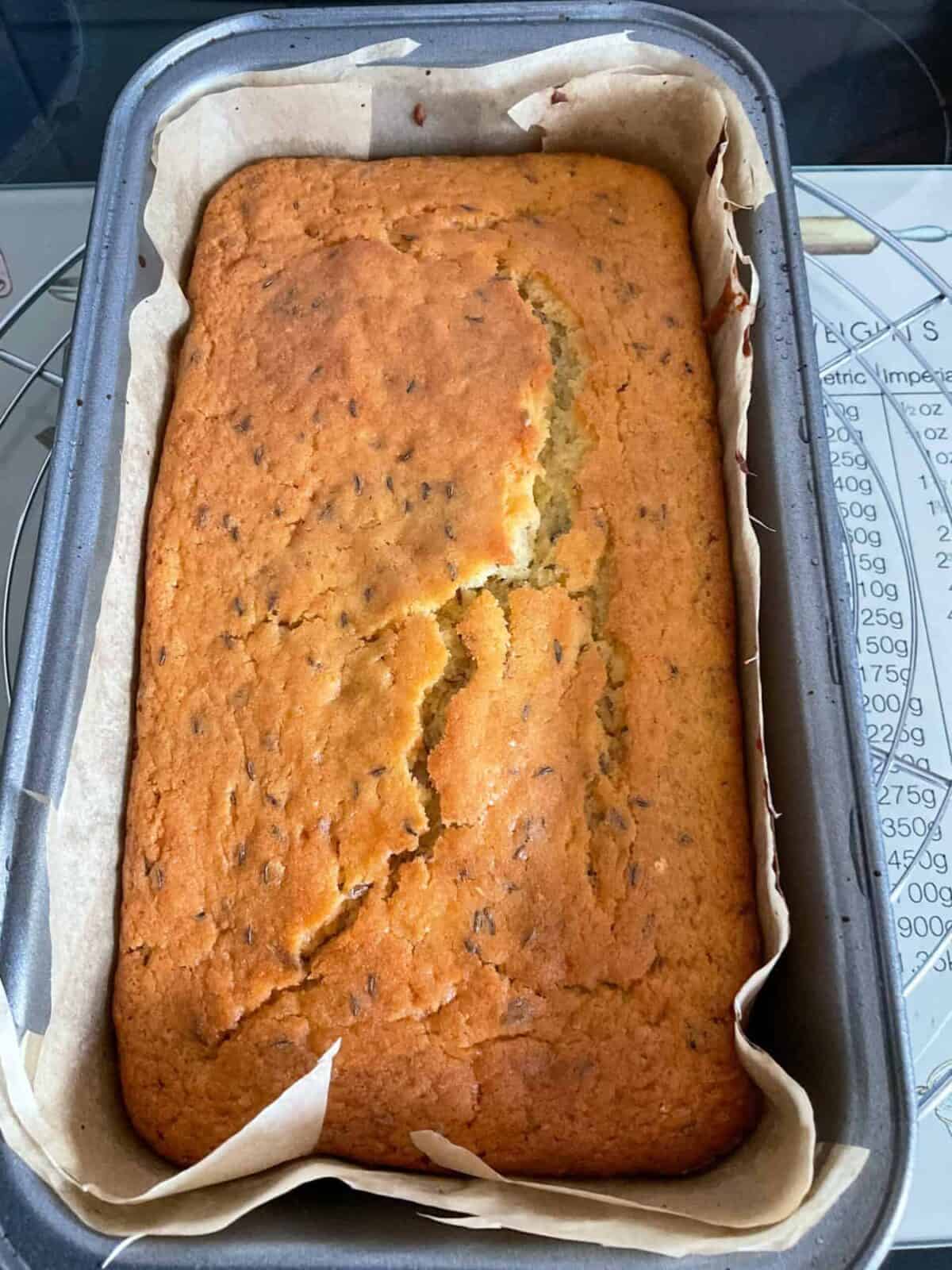
8. Scoop the cake mixture into a prepared loaf pan and bake for 35-45 minutes until golden brown, firm, and a skewer popped in comes out clean.
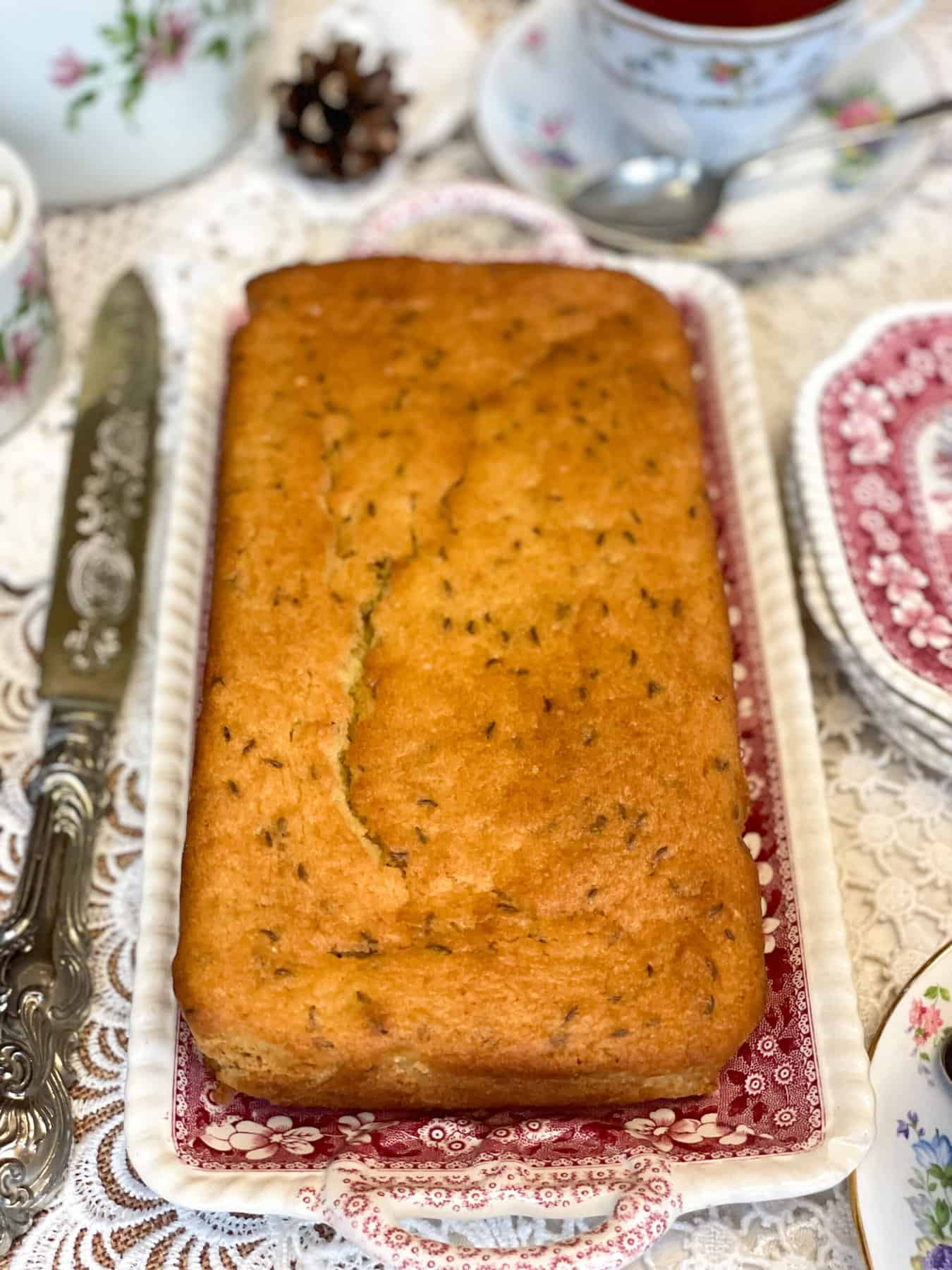
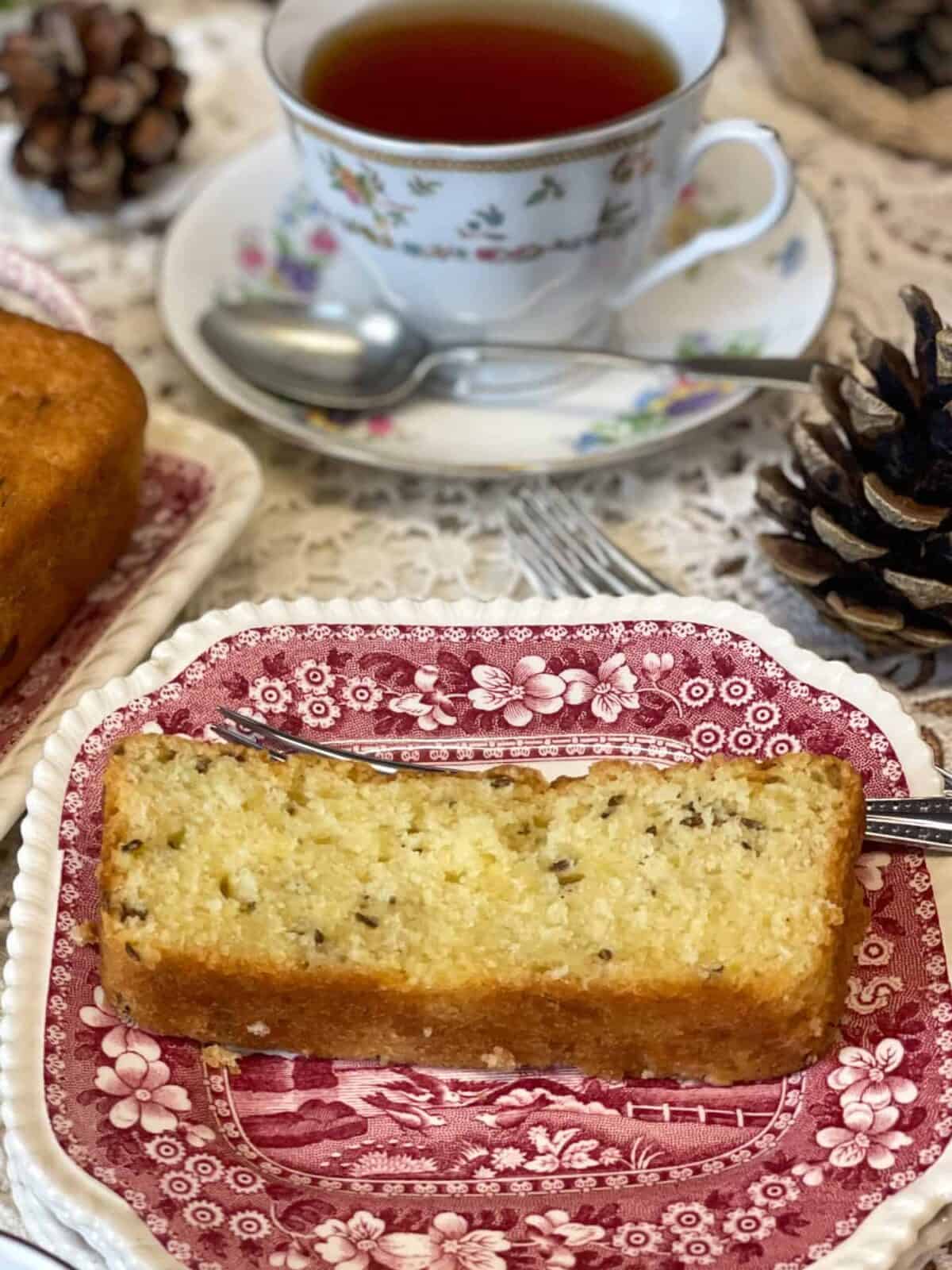
9. Cool the cake on a cooling rack before slicing a piece to enjoy along with a nice cup of tea or coffee. Serving suggestion: for a nice lunch, picnic, or snack you can spread butter or margarine over your cake and serve with slices of cheese and fresh tomatoes.
Recipe notes
Storage
Seed cake can be wrapped in baking paper and stored within a cake tin or food container and kept somewhere cool and dry. It will be fine for 3-4 days, possibly for a few extra days as it's a nice sweet moist cake that does keep well.
Or freeze, well wrapped, for 2-3 months.
FAQ'S
Yes, if preferred the caraway seeds can be replaced with poppy seeds or perhaps fennel seeds.
If you go with poppy seeds, some people like to soak the seeds before baking as this can improve their flavour and texture, as well as making the seeds easier to digest.
To soak the poppy seeds simply place them in some water and soak for a few hours. Drain the water and pat the seeds dry before using in the recipe.
However, pre-soaking isn't essential as many, including myself, have used poppy seeds in baking directly from their package.
Caraway seeds taste somewhat aniseed-y with background tones of liquorish but these flavours are not too strong, and there are also citrusy, minty, and peppery tones to the seeds. Some people with good taste buds may detect some bitterness in caraway seeds which can be a bonus, as when baked within a sweet, moist, and buttery cake the flavours can't help but compliment each other!
Yes, there are a few differences in texture and taste between caraway seeds and poppy seeds. Caraway seeds have a strong flavour that is a bit earthy and peppery with a hint of citrus and anise. The seeds add a warm taste to the dish, whereas poppy seeds have a nutty and slightly sweet taste, which is much milder compared to caraway seeds. As poppy seeds add a much subtler flavour to the cake these may be preferred especially for kids.
Regarding the texture, caraway seeds are small, crescent-shaped seeds with a slightly crunchy texture when baked into a cake, whereas poppy seeds are tiny, round, and have a nice crunchiness.
In sum, if you prefer a more strong, earthy flavour that compliments the buttery sweet cake then go for caraway seeds, but if you want a milder, nutty taste, go for poppy seeds.
Yes, instead of fresh lemon juice you can use apple cider vinegar or if nothing else is available use white distilled vinegar.
Instead of lemon zest you can use lime, orange, or grapefruit zest, or even a teaspoon of orange, lemon, or any citrus flavouring or extract. Or simply omit the lemon zest, although it does provide a nice flavour.
The cake mixture may appear curdled after adding buttermilk due to the reaction between the acidic buttermilk and the fats in the margarine or butter. This can cause the fats to seize up and create a curdled appearance. It's a common occurrence when baking, especially when dealing with acidic ingredients and fats.
The good news is that this is perfectly normal and won't affect the final outcome of the cake. Once the dry ingredients, especially flour, are added to the mixture, the batter will smooth out and the curdled appearance will fade. As the cake bakes, the ingredients will come together, resulting in a perfectly textured cake.
Seed cake and Madeira cake are similar in some ways, but they have distinct differences in taste, texture, and ingredients. Both cakes are known for their denser texture and buttery flavours, compared with the lighter sponge cake, although the Madeira cake is considered a little drier in texture.
Both types of cakes are usually baked in a loaf pan, which does give them a similar shape and appearance.
The main difference between the two cakes is the flavour as seed cake is characterized by the use of caraway seeds or poppy seeds, which provide a distinctive taste. Madeira cake, on the other hand, is a simple sponge cake flavored with lemon zest and sometimes a hint of vanilla. Although seed cakes are often also flavoured with lemon.
Madeira cake is often sprinkled with sugar on top before baking, or served with a sprinkle of powdered sugar once cooled, while seed cake is usually served plain or possibly with a white icing glaze especially if it is a poppy seed cake.
Both the Madeira and seed cake are ideal with a cup of tea, but the Madeira cake was originally created back in the 1800s as a cake that would go well with a glass of Madeira wine. Whereas, seed cake during the 1800s was a popular nursery and children's cake.
In conclusion, seed cake and Madeira cake share some similarities in terms of texture and serving occasions, but they differ in flavour, ingredients, and serving style.
A nice cup of tea, coffee, or chilled glass of your favourite milk are the perfect accompaniments to a slice of seed cake. However, seed cake can also be enjoyed with fresh fruit, fruit jam or berry coulis, whipped cream, yogurt, or hot custard.
For a savoury accompaniment, slices of cheese are a tasty contrast to the soft sweet cake. It may sound odd having cheese with cake, but there are plenty of old-fashioned British cakes that are traditionally paired with cheese, Including the traditional Fruit Loaf Cake.
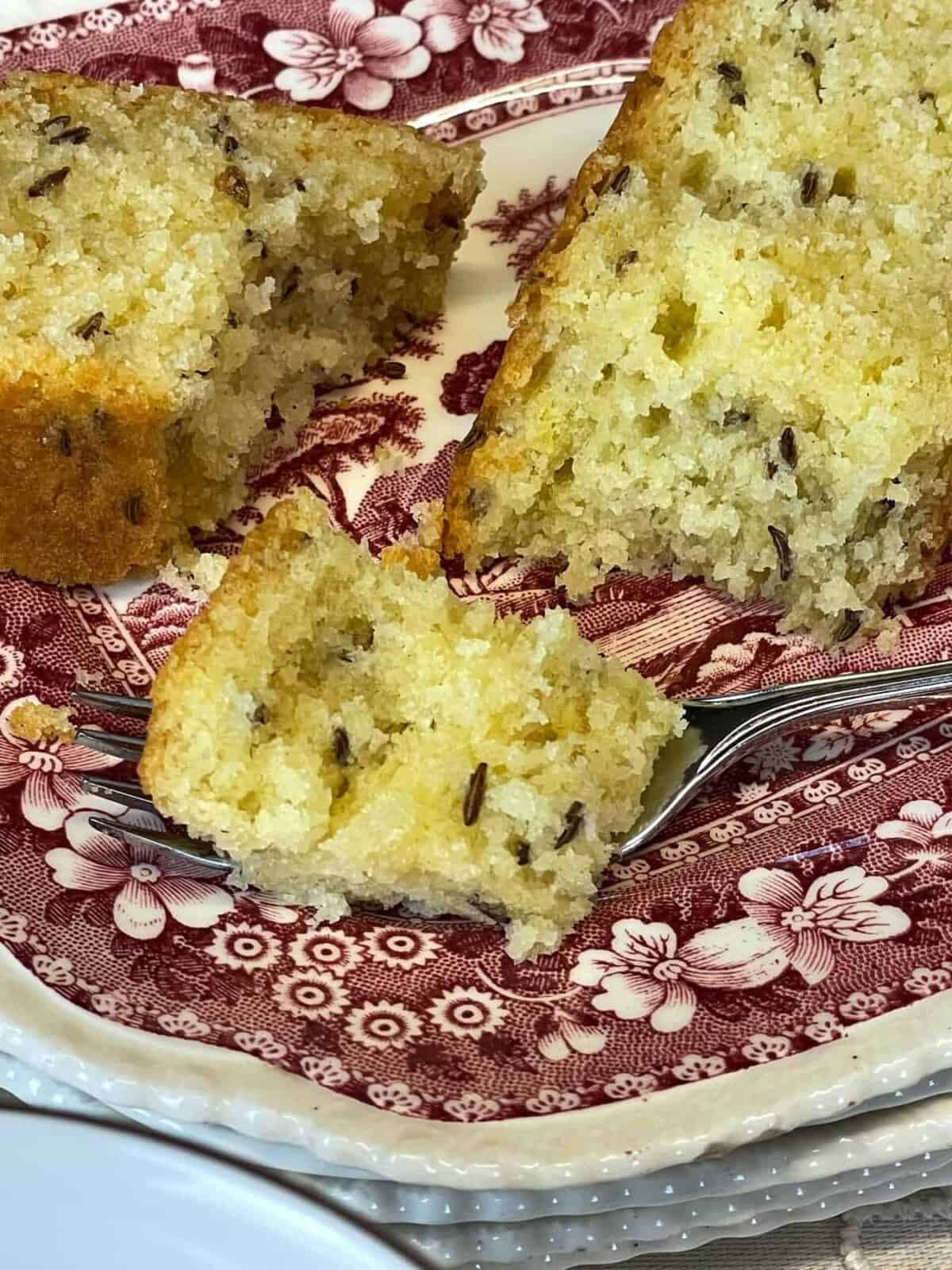
Old-Fashioned Seed Cake is similar to a Pound Cake or Madeira cake. Our seed cake recipe is perfect for egg and dairy-free baking and you won't feel like you are missing out when you have a generous thick slice of this seed cake along with a nice cup of hot tea.
More traditional bakes - made egg-free & dairy-free
We love traditional favourite teatime bakes that have stood the test of time throughout history, but we also love vegan-friendly ingredients so are always creating and adapting old-fashioned recipes into tasty vegan bakes that are suitable for everyone to enjoy.
Using everyday pantry ingredients is very important as we want everyone to be able to bake these delicious homely bakes. Omitting eggs and butter from bakes is a great budget-friendly choice and the end bake tastes just as good. A few of our family favourites are this vegan Jam and Coconut Sponge, and this Old-Fashioned Spiced Applesauce Cake, and this Pumpkin Fruit Loaf Cake. And our kids really love this Old School Chocolate Sponge Cake.
For more baking ideas do check out our family collection of Vegan Baking Recipes.
***please note: for US measurements click the 'US customary button' within the recipe and the measurements will switch to tablespoons, cups, and ounces.***
📖 Recipe
Old-Fashioned Seed Cake
Equipment
- Jug or small bowl
- 2Ib loaf pan around [9-10 x 5½ x 2½ inch] [25 x 14 x 6 cm] in size, and lined with parchment or baking paper
- Mixing bowl
- electric hand whisk or use a mixing spoon and mix by hand
- sieve
- mixing spoon
- cooling rack
Ingredients
Vegan buttermilk:
- 220 millilitres milk [we use soya milk as due to its high protein content it curdles well, but you can use other plant-based milks if preferred, or if you have other dietary requirements use your usual milk]
- 1 tablespoon fresh lemon juice [or apple cider vinegar]
Cake:
- 170 grams margarine or butter [use one suitable for baking, we used Stork baking spread]
- 140 grams granulated sugar [or castor sugar, [if using the cup measurement, measure out a generous ⅔ of a cup of sugar!]
- 210 grams self-raising flour
- 1 teaspoon baking powder
- 4 teaspoons caraway seeds [or poppy seeds]
- 2 teaspoons lemon zest
- 1 pinch salt
Instructions
Prepare the buttermilk:
- Add the milk and lemon juice to a jug, stir well, and leave to curdle for at least 30 minutes. This step can be done a few hours before its required so it will be ready when needed.220 millilitres milk, 1 tablespoon fresh lemon juice
Preheat the oven to 160 Fan, 180C, 350 Fahrenheit, Gas 4.
- Grease the loaf pan with some extra margarine and line the pan with parchment or baking paper.
- Add the margarine and sugar to the mixing bowl and with an electric hand whisk mix for about 45 seconds, or if using a mixing spoon beat the mixture by hand until fully incorporated.170 grams margarine or butter, 140 grams granulated sugar
- Next, pour in the buttermilk and whisk for about 20 seconds. The mixture will look curdled but it will be fine once the dry ingredients are added.
- Sift the flour and baking powder into the mixing bowl directly onto the whisked ingredients. Add the salt, seeds, and lemon zest.210 grams self-raising flour, 1 teaspoon baking powder, 4 teaspoons caraway seeds, 1 pinch salt, 2 teaspoons lemon zest
- Mix everything together using a mixing spoon, and then scoop the cake mixture into the loaf pan. Level out the surface.
- Place the loaf pan onto the middle oven shelf, and bake for 40-45 minutes until risen, golden brown, and firm to the touch. The sides of the cake will also be coming away from the edges of the loaf pan and a skewer or similar popped into the middle of the cake will come out clean when the cake is fully baked.Fan ovens tend to bake quicker, than other types of oven, so check your cake at the 40 minute mark or a few minutes before.[We used an electric oven, so baked at 180C, and our cake was ready after about 44 minutes.]
- Once baked the cake will be golden all around the outsides and once cool the insides will be soft, fluffy, moist, and spongy with the outsides slightly chewy. The surface of the cake may have a thin crack in the middle and this is perfectly normal.
- Leave the cake to cool in the pan for about 20 minutes before carefully removing from the pan to a cooling wrack, and peeling down the parchment paper from the sides. Allow the cake to completely cool.
Notes
- Nutritional information is for guidance only and is not an exact calculation as ingredients vary.
- For the purposes of this recipe we used a 240ml US measuring cup which equalled 1 cup.
- 1 cup of our measured flour equaled 140grams, and half a cup equaled 70grams flour.
- The flour was not sifted before measuring in the cup.
- If using cup measurements, please note we used a ⅔ measuring cup of sugar and it was a generous measurement!
- Weighing scales are highly recommended as they will provide the best baking outcomes.
- Seed cake can be stored for 3-4 days wrapped in parchment paper and placed into a cake tin or container. Although, as this is a nice sweet moist cake if kept somewhere cool it is usually fine for a few extra days.
- Of freeze, well wrapped, for 2-3 months.
- If caraway seeds are not liked these can be replaced with poppy seeds.
- Instead of lemon juice apple cider vinegar can be used.
- Instead of lemon zest, orange or lime zest can be used.
- Your usual milk will be fine for this cake.
- We used soya milk does seem to make the best dairy-free buttermilk as if given enough time to react with the lemon juice [at least 30 minutes or longer] it becomes thick and curdled, which when used for cakes provides a good texture. However, almond milk is a close second.
- We used Stork baking spread, but this can be replaced with your usual butter or margarine that you use for baking.
- Poppy seeds can replace the caraway seeds.
- See our recipe notes and FAQ section above for more useful information.
Nutrition
Prepared our tasty Old-Fashioned Seed Cake? Do let us know how you got on with the recipe by popping us a comment below and clicking on the star ratings. It's very much appreciated, Thanks so much, Jacq x
RiaSunflower says
This was the first time I'd ever made Seed Cake, although I've always known about it through literature, I'd never experienced it or seen it anywhere. I finally made it with soaked caraway seeds and Flora Plant Butter.
It was truly delicious, light, buttery and fluffy therefore, I'm not surprised it was requested by Balin etc. (I must read the 📙) 🙂
Thank you for a such a delectable, vegan cake recipe. 🙂
Jacq says
Hi RiaSunflower, You are very welcome. Thanks so much for coming back to comment. I am so glad you enjoyed the seed cake! The thought of a seed cake doesn't appeal to many people at first but it's a classic for a reason as it is surprisingly very tasty. I do recommend reading The Hobbit as well! Jacq x
Michelle Corcoran says
hi, I have never made a seed cake but a friend has asked me to make it for her. I no she is not vegan. can I use butter milk instead of the oat milk?
Jacq says
Hi Michelle, Yes I would think the buttermilk should work fine as a replacement, Jacq x
Ceri says
Super easy to make and really tasty.
Jacq says
Hi Ceri, That's so good to read. Very happy you enjoyed the seed cake. Thanks for coming back to leave your comment. Jacq x
Mildred kelly says
Cake looks delicious. Myself, daughter and Granddaughter have ceilic disease which is an autoimmune disorder. Was wondering could this cake be made with pure butter and shop bought buttermilk
Jacq says
Hi Mildred, Yes I would think those ingredient swaps would be fine. As you mention celiac disease, are you also changing the flour? Jacq x